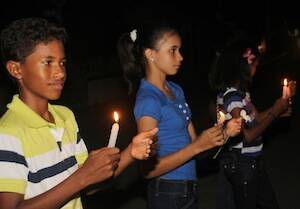Tonight we are breaking the silence,” said Regino Martínez, the Jesuit priest who is head of Solidaridad Fronteriza, a human rights and immigration organization in the Dominican Republic. “Tonight, we lose the fear.” On Oct. 4 he led a candlelight procession to the aptly named Massacre River on the border with Haiti in a commemoration of the 75th anniversary of the Parsley Massacre. During a five day period in early October 1937, Dominican soldiers slaughtered thousands of Haitians, many of them born in the Dominican Republic, under orders from the Dominican dictator Rafael Trujillo. Between 9,000 and 30,000 people died in the violence, a slaughter now largely forgotten. Haitians call it kout kouto-a, “the stabbing. “Dominicans refer to it as el corte, “the cutting.” It earned the nickname Parsley Massacre because some soldiers are said to have carried parsley sprigs. When they showed the parsley, victims were told to say the word. If people could not pronounce it in the Spanish way, they were killed.
'Parsley Massacre' Remembered
Show Comments (
)
Comments are automatically closed two weeks after an article's initial publication. See our comments policy for more.
The latest from america
In these dark times, surrounded by death and destruction in Gaza, we hear the command in the first reading, “Choose life.” What are the ways we can do this in a world that seems to have gone mad?
On July 31, Pope Leo XIV announced that St. John Henry Newman, English theologian, educator, and writer who converted to Catholicism after being an Anglican priest, will be named a Doctor of the Church.
The chair of the USCCB Committee on International Justice and Peace put out a statement on July 31 demanding more humanitarian action for those in Gaza.
Latin Mass, Eucharistic Revival, real presence: In every age—including our own—the church has seen a complex Eucharistic landscape.








